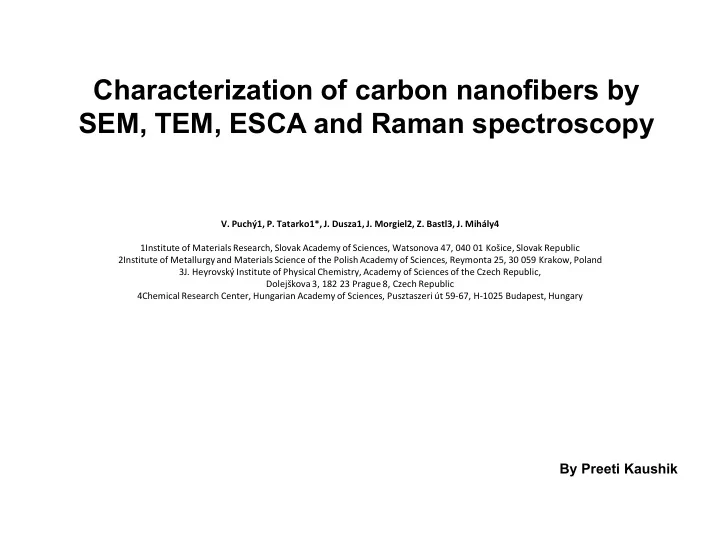

Characterization of carbon nanofibers by SEM, TEM, ESCA and Raman spectroscopy V. Puchý1, P. Tatarko1*, J. Dusza1, J. Morgiel2, Z. Bastl3, J. Mihály4 1Institute of Materials Research, Slovak Academy of Sciences, Watsonova 47, 040 01 Košice , Slovak Republic 2Institute of Metallurgy and Materials Science of the Polish Academy of Sciences, Reymonta 25, 30 059 Krakow, Poland 3J. Heyrovský Institute of Physical Chemistry, Academy of Sciences of the Czech Republic, Dolejškova 3, 182 23 Prague 8, Czech Republic 4Chemical Research Center, Hungarian Academy of Sciences, Pusztaszeri út 59-67, H-1025 Budapest, Hungary By Preeti Kaushik
Aim of the work Investigate the structure, morphology and composition of carbon nanofibers (CNFs) using different characterization techniques: -Scanning electron microscopy (SEM) -Transmission electron microscopy (TEM) -High resolution electron microscopy(HRTEM) -Electron spectroscopy for chemical analysis(ESCA) -Raman spectroscopy
Introduction • Carbon nanofibers (CNFs) : cylindrical or conical structures, have diameters varying from a few to hundreds of nanometers and lengths ranging from less than a micron to millimeters. • Carbon nanotubes (CNTs) have graphene layers parallel to tube axis but in CNFs the orientation of graphene layers is not parallel to fiber axis. • CNTs are CNFs with graphene layers wrapped into perfect cylinders. • Like CNTs, CNFs also have good electrical, thermal and mechanical properties which make them suitable for many applications.
Characterization methods • SEM: Examination of length, diameter and morphology of CNFs. • TEM and HRTEM: Observe the crystal structure and graphite layer arrangement. • ESCA: Finding the chemical composition and carbon bonding in the material. • Raman scattering: To study the quality of the material and the microscopic structure of the CNFs.
SEM and TEM SEM- • Image: Scanning with a focused beam of electrons • Source of electrons: thermionic emission, field emission • Electron gun operating voltage: 0 to 60 keV • Detected signals: Secondary electrons (SE), Backscattered electrons (BSE), X-rays, cathode - luminescence light • Resolution: Tens of nm • Penetration depth: upto 1 nm TEM- • Image: By electrons transmitted through the ultra-thin sample • Electron beam: up to 300 keV (limited to 100 keV) • Penetration depth: upto 1 A o
TEM SEM
Raman Spectroscopy • Principle: Inelastic scattering of monochromatic radiation. • Energy is switched between the photon and the energy levels of molecule. • Raman spectra: G-band (1570 cm -1 ) D-band(1350cm -1 ) RBM (Radial Breathing mode < 200 cm -1 ) • I D :I G : Defect density of the sidewall.
Results and discussion SEM images -(a) Morphology of the carbon nanofibers, characteristic morphology with mix of cylindrical and bamboo-shaped nanofibers, (b) an example for smooth CNF of small diameter and rough CNF of large diameter
SEM Observation s • Cylindrical hollow tubes, usually with free ends and smooth surface • Bamboo-shaped nanofibers with a waved surface. • Nanofibers with a straight-line shape and rough surface. • The outer diameter is 50 – 250 nm and inner diameter from 20 nm to 230 nm. . • The length of the CNFs is up to several micrometers .
Histogram illustrating the distribution of the diameters of the fibers
TEM Observations • In cylindrical hollow fibers the wall is smooth and uniform, graphite layers are parallel to the axes of the fibers. • The bamboo-shaped fibers are composed of multi-walled graphite structure. As the carbon diffusion was not continous during growth, there was a periodic variation of fiber diameter. Characteristic morphology of CNFs by TEM, cylindrical and bamboo-like CNFs.
HRTEM of a cylindrical nanofiber with the HRTEM of a bamboo-shaped nanofiber wall thickness of approximately 28 nm and with the wall thickness of approximately hole diameter of approximately 30 nm. 18 nm. The interlayer spacing of the The interlayer spacing of the graphite graphite layers in this wall is layers is approximately 0.35 nm. approximately 0.33 nm.
• G-band at 1600 cm -1 related to graphitic layer and the D-band at 1282 cm -1 related to disordered structures in carbon materials . Raman spectra of carbon nanofibers at 1064 nm excitation wavelength
• The additional two weak noisy bands observed at around 1150 and 1370 cm -1 can be assigned to the mixed bonds between sp 2 and sp 3 carbon for amorphous carbon structures • The ratio of intensities of D-band to G-band (I D /I G) was 1.69. • An increase in relative intensity of the D-band near- infrared excitation (1064 nm) is related to a larger electron-phonon interaction for D-band with respect to G-band .
Conclusion • Cylindrical and bamboo shaped fibers identified. • Cylindrical fibers: defect-free, distinct graphite layers parallel to the fiber axis. • Bamboo-shaped fibers: contain defects at the nano-level. • Outer diameter of the fibers: 50 nm to 600 nm • Length of the fibers: several micrometers to several tens of micrometers. • The fibers contain 99.05 at.% carbon and 0.95 at.% oxygen with a binding energy of O(1s) electrons of 532.7 eV. • G-band at 1600 cm -1 and D-band at 1282 cm -1 are very similar to the positions of the same bands for carbon fibers and different carbon nanotubes
Thank you
Recommend
More recommend